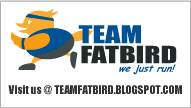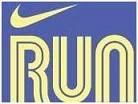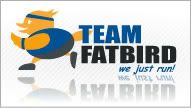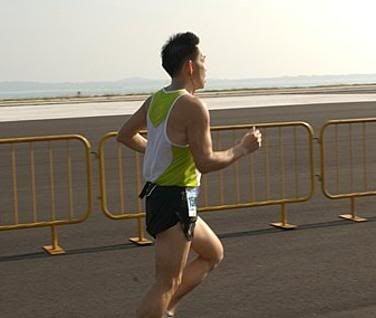Running Over 40
By the late thirties, and sometimes as early as thirty, we can see the following:
Increasing weight
Thickening waistline
Declining strength
Poor posture
Lack of vigour
Loss of flexibility
Slower movements
Breathlessness
Lack of stamina
Thinning hair
Wrinkles
Increasing weight
Thickening waistline
Declining strength
Poor posture
Lack of vigour
Loss of flexibility
Slower movements
Breathlessness
Lack of stamina
Thinning hair
Wrinkles
Running over Forty
by Bruce and Sue Tulloh
(pub. Tulloh Books 2001 Price £10.99 or US$15.40 + Postage & Packing)
An extract:by Bruce and Sue Tulloh
(pub. Tulloh Books 2001 Price £10.99 or US$15.40 + Postage & Packing)
There was a time when a sportsman of any kind was considered too old at 28, over the top at 30. 'Ageing legs', the commentators would say, knowingly. Sport was alright for young people and students, but certainly too frivolous for anyone over thirty, and downright irresponsible for a family man. The older you got, the less exercise was recommended.
These prophecies were, of course, self-fulfilling. We say we are too old, so we stop taking exercise, so we become less fit, so we cannot do as much. How things have changed! Nowadays the family man is being urged to take more exercise, cut down on his cholesterol intake and reduce his waistline, for the sake of his heart.
The first question people will ask is: am I too old to take up running ? The answer to that is that you are never too old, though it must be said that the number of ninety-year-olds in competition is pretty small. What they are really asking is : Is it too late? Can I still hope to perform as well as I did when I was 18?
Don't worry! The world is full of examples of what can be done; som0e of them you will come across in this book. The seventy-year-old weight-lifter is stronger than the average thirty-year-old, the seventy-year-old ballet dancer is more flexible than the average thirty-year-old and the fit seventy-year-old runner will outrun the majority of thirty-year-olds at any distance over a mile.The 70-year-old Canadian Ed Whitlock recently ran 10 kilometres in just over 38 minutes, which would put him in the top 10% of most races in Britain or North America.
Such people owe their achievements not to the fact that they were outstanding when they were younger but to the fact that they have continued to practise the activity they enjoy.
It's easier for those who have been famous, because society tolerates them, even celebrates them; we can recall Jean Borotra and Kitty Godfrey playing tennis into their nineties, or Gene Sarazen teeing off at Augusta in the Master's. For those who are less distinguished, though, it sometimes requires moral courage, and this book is designed to reinforce that courage.
When we are young, we feel immortal and in a sense we are, because our cells renew themselves constantly. As we get older, the rate of cell division slows down, there is a loss of elasticity and some tissues perform less efficiently (see Ch. 2). The questions we need to look at are:
How early do these changes set in?
Is there anything we can do to reverse the process?
What level of performance can we expect at a certain age?
Athletics has the advantage of being completely measurable, so we can see just what is happening.Having been a teacher for thirty years, I have seen that in our civilization, people reach their physical peak between the ages of 16 and 18, and from then on their physical condition depends on their physical activity. Former pupils who come back a year or two after leaving school are already less fit, unless they have got into active sport One of the spin-offs from the Vietnam war was that American surgeons had the opportunity of examining a lot of young corpses, and they found that most of those in the 19-21 age group already showed signs of degeneration, in the sense of increased fat storage and higher fat levels in the blood .
For those who take up regular training, it is quite different. We can look at records and see that it is possible to remain at the very highest level up to the age of 35, if not further, as long as you have the motivaton to train properly. Linford Christie and Merlene Ottey showed that this is true for the sprints. In the longer distances, we can quote the examples of Carlos Lopes winning the World cross-country title and the Olympic marathon at the age of 37 and Eamonn Coghlan running a sub-four-minute mile at the age of 40.
The message we can take from this is that it is possible to reverse most of the effects of ageing by taking the right kind of exercise.
What are the signs of ageing? By the late thirties, and sometimes as early as thirty, we can see the following:
Increasing weight
Thickening waistline
Declining strength
Poor posture
Lack of vigour
Loss of flexibility
Slower movements
Breathlessness
Lack of stamina
Thinning hair
Wrinkles
These outward signs are often accompanied by a general feeling of heaviness and malaise, sleeplessness and loss of appetite.
Almost all of these things can be reversed by exercise:
Your weight and your waistline will be brought down by burning up more calories per week and by sensible eating.
Your muscular strength will improve rapidly with training
As your abdominal and back muscles get stronger and your fat declines, your posture will improve.
The confidence and sense of well-being which come from being fit will make you more vigorous.
Flexibility can be improved by regular stretching exercises.
With less weight to carry and with increased fitness and strength, you will move faster and more easily.
Training brings a big improvement in oxygen intake. You will still get breathless when training hard, but you will be able to cope easily with ordinary life.
The increase in your powers of endurance will surprise you. Those who couldn't jog a mile can become fit enough to run a 26-mile marathon.
This still leaves us with the thinning hair and the wrinkles, but somehow, when you are fit healthy and happy about your body, they don't seem to matter as much.
How to get the book















0 Comments:
Post a Comment
<< Home